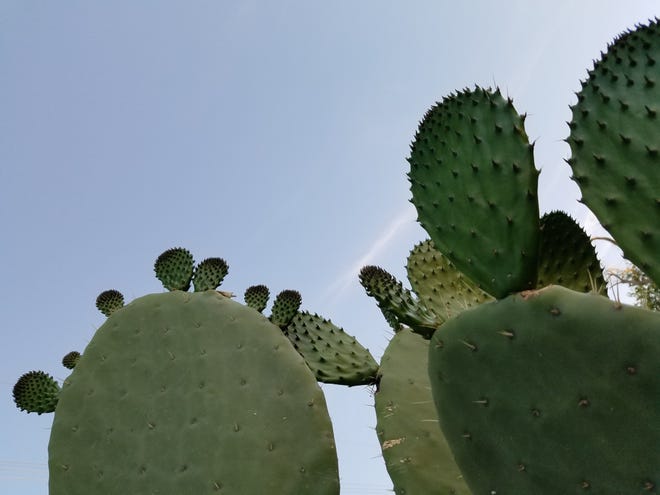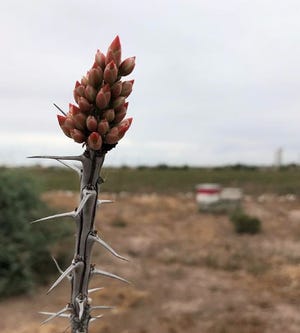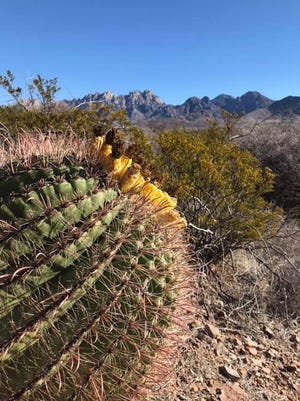Meet your neighbors: Key plants of the Chihuahuan desert
Here are a few of the resilient, drought-tolerant plants that give our region its unique character
Rubí Orozco Santos and V. Quevedo
La Semilla Food Center
This article was originally published in the Las Cruces Sun News» on August 03, 2019.
 An archetypal plant of the Chihuahuan desert, prickly pear cactus consists of pads ranging in color from green to purple with variable amounts of spines and seed-filled fruits covered in tiny barbs from which it derives its name. La Semilla Food Center
An archetypal plant of the Chihuahuan desert, prickly pear cactus consists of pads ranging in color from green to purple with variable amounts of spines and seed-filled fruits covered in tiny barbs from which it derives its name. La Semilla Food CenterEstablished in 1852, the City of Las Cruces is a relatively new member of the Chihuahuan desert, the largest desert in North America and the most biologically diverse desert in the Western Hemisphere.
Here, we introduce you to just a handful of the many resilient, drought-tolerant plants that give our region its unique character.
We recognize these plants have been and continue to be used for food and medicine by the original inhabitants of these lands. The area currently known as Las Cruces has been historically stewarded by various indigenous peoples, including the Mogollon, Mescalero Apache, Chiricahua Apache, Piro, Manso, and Tiwa.
More: Research yields valuable information for public land management
Creosote bush: It is this plant that gives monsoon rains their distinctive scent. Also known as “gobernadora” (Spanish for governess) for the way it reigns the landscape for miles at a time, it has multiple flexible branches with olive green, fragrant leaves. From March through September, the bushes are adorned by abundant yellow flowers. Fluffy white spheres – its fruit – appear prolifically in late summer, giving it a festive flair. Its antimicrobial properties make it a natural addition to homemade balms to soothe minor cuts, scrapes, and insect bites.

Ocotillo serves as natural fencing. Its stem and flowers have been used medicinally for hundreds of years. La Semilla Food Center
Ocotillo: With tall, single branches covered in thorns, this plant is easy to spot. A close look at some branches reveals marbled, purple lines. In the summer, the staff-like branches are carpeted by small tear-drop shaped, jade green leaves and are crowned with crimson flowers favored by hummingbirds and bees. Ocotillo serves as natural fencing. Its stem and flowers have been used medicinally for hundreds of years.
Mesquite: Mesquite trees belong to the legume family. They have woody, mauve branches with single or multiple stems containing small, linear leaves. They release hard, golden pods in the summer in generous numbers. A low-glycemic energy source, the pods have traditionally been ground into flour as a source of sustenance. Resourceful exploration revealed uses for all parts of the tree: the bark serves for basketry, the trunk for firewood, the branches as weapons, the leaves as medicine, the sap as glue.
Barrel cactus: The barrel cactus can grow to be more than seven feet tall – generally standing as a single column unless an injury causes it to split. Covered in sharp spines, it is topped with bright yellow fruits that resemble tiny pineapples. These fruits release easily when ripe and are edible, as are the seeds inside.

The barrel cactus can grow to be more than seven feet tall – generally standing as a single column, unless an injury causes it to split.
La Semilla Food Center
Silverleaf nightshade: Also known as “trompillo,” this plant may be classified as a ‘pesky weed’ by some. Yet, it plays an integral part in the creation of Queso Asadero, a raw milk cheese historically produced in Mexico that continues to be made along the borderland. Trompillo supplies a plant-based rennet traditionally used to curdle the milk! One must fully understand how to work with this plant; it has been known to poison some animals as well as humans.
Prickly pear cactus: An archetypal plant of the Chihuahuan desert, prickly pear cactus consists of pads ranging in color from green to purple with variable amounts of spines and seed-filled fruits covered in tiny barbs from which it derives its name. Prickly pear fruits are refreshing and boast more potassium than bananas. Both the fruit and the pads are low-glycemic energy sources. The pads are a quintessential ingredient of regional cuisine. They are high in antioxidants and can be prepared raw or cooked.
There are many more members of the Chihuahuan desert family, including devil’s claw, yucca, and amaranth, to name a few. We encourage you to get to know your extraordinary plant neighbors while being careful not to overharvest: only collect what you truly need.
Unfortunately, the Chihuahuan desert is also one of the most endangered regions in the world due to overgrazing, urbanization, and overcollection of native plants.
Thanks to indigenous, earth-based practices passed down for generations, desert dwellers don’t see the region as a place of scarcity but as a place of sustenance and healing.
Sources: National Park Service, Chihuahuan Desert Inventory & Monitoring Network, A Guide to Plants of the Northern Chihuahuan Desert, DesertUSA, SlowFood USA, UT Austin Ladybird Wildflower Center, Native Land Digital.
This article is part of a special series by La Semilla Food Center that seeks to spark curiosity in and increase appreciation for the Chihuahuan Desert ecosystem.


